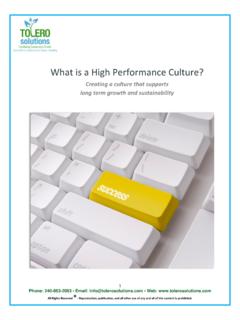Transcription of Rebuilt to last: The journey to digital sustainability.
1 Rebuilt to last: The journey to digital sustainability. The digital economy has its own rules. For traditional organizations, adapting to them involves much more than embracing technology. It means transforming how they work. And not just once. Organizations need to embed this ability to change into their DNA, so they can continually respond to a fast-moving new reality and become digitally sustainable. 2 The digital s inside02 The digital New realities, new Critical What do digital leaders do differently?08 A roadmap to Driving digital seems everyone s talking about digital transformation. But at Korn Ferry, we re talking about something more. We re talking about digital sustainability.
2 Why? Because digital transformation generally means using technology to drive change. And secondly, because transformation tends to imply a defined end-point. We don t think businesses should be looking at things in this way. digital sustainability is the ability to thrive in a continuously changing digital world. This requires more than just keeping up with the latest technology. To succeed, firms need to weave the ability to continually transform into the very fabric of the organization: into their culture, ethics, values, beliefs, processes, and practices, and into the mindset of their entire is a huge change for traditional organizations. Over decades they have perfected ways of working that deliver efficiently and effectively at scale but don t lend themselves to agility and research highlighted in Harvard Business Review shows that the greatest challenges facing companies going through digital transformation are top-down structures, an inability to experiment, limited change management capabilities , legacy systems, a risk-averse culture, and an inability to work across silos (HBR, 2016).
3 Only by re-imagining their businesses, can leaders make their organizations digitally sustainable. Some will rise to the challenge. They ll move fast, and gain a critical edge over their competitors. Others will fall by the wayside. The harsh reality is that fifty years ago, the average lifespan of a Fortune 500 company was around 75 years; today, it s less than 15 years and getting shorter all the time. This paper explores how traditional organizations can make the journey to digital sustainability. It identifies the organizational capabilities required for a company to continually transform, and offers a blueprint for how to get there. Taking a digital -first approach is a journey towards a new way of doing business.
4 It requires a mindset shift first, followed by technology and process shifts. You can t overhaul your platforms and solutions without changing your culture and thinking. That risks replacing legacy infrastructure with modern technology, at great expense, with little impact on customer and business outcomes. Brett Pitts, Head of digital , Wells Fargo| The journey To digital Sustainability |3 New realities, new opportunitiesWe live in a digital economy: a virtual environment that s changed the rules of doing business. It has made disruption the norm. It has put customers, not companies, in charge. And it has transformed workforce dynamics, as the born digital millennials come to prominence in the workplace.
5 But it is also ripe with opportunity. Organizations can engage with customers and employees like never before. It holds the potential to drive operational efficiencies, save time and money, and explore new commercial avenues. When it s far cheaper to build an app than a manufacturing plant, there are greater returns on offer, for significantly lower investment. It s predicted that 41 percent of enterprise revenue will come from digital business by 2020 that s almost double what it was in 2015 (Gartner, 2016). For the Googles, Ubers and Facebooks of this world, facing these challenges, and realizing and exploiting these opportunities is second nature. But for traditional firms, it s a whole new world.
6 So how can these organizations seize the opportunities of the digital economy? To help answer this, Korn Ferry gathered views from leaders who are driving transformation at some of the world s most successful organizations. The company also drew on the experiences of its own business transformation experts, and research by Korn Ferry and other authorities on business change. This enabled the firm to identify: the leadership and organizational capabilities that enable digital sustainability. a roadmap to become digitally capabilities Korn Ferry believes that to achieve digital sustainability, the following five leadership and organizational capabilities are essential: 1. Discipline and focus.
7 2. Agility. 3. Connectivity. 4. Openness and Empowerment and Discipline and focus Organizations that successfully transform for a digital world are clear about what digital means to them. They define their desired outcomes, and focus relentlessly on achieving them. They do this by prioritizing the things that drive the most value typically customers, data, and talent. They are also disciplined about execution. They decide quickly what to invest in, then draw on their strengths to implement it efficiently, effectively, repeatedly, and at scale. You must be crystal clear on what the desired outcome is, and how it will benefit customers. Then push relentlessly for it. Stay incredibly focused on what will have the biggest impact, and try to avoid the myriad of distractions.
8 Michelle Peluso, Chief Marketing Officer, IBM42. AgilityThe new world moves at lightning speed. Digitally sustainable organizations are agile: they think fast, decide fast, execute fast, fail fast, learn fast, and scale fast. Agile businesses run planning and execution in parallel and they invest in scenario planning, so they can act promptly when opportunities arise. They are also prepared to take risks. They create solutions based on what they already know, then evolve them as customer feedback comes in. This means streamlining reporting lines; engaging a wider group of stakeholders at the outset; sharing ideas and plans before they re fully formulated; and seeking input along the firms are also quick decision-makers.
9 They ll launch several projects at once, to see what works and what doesn t, then make rapid decisions about what to invest in, and what to draw a line under. When they commit, they do so wholeheartedly, with significant amounts of budget and resource. And when they fail, they fail fast, and learn from their ability to move fast also depends on developing learning agility across the enterprise. Agile businesses develop their people to continually acquire new skills, learn from experience, face new challenges, and perform in an ever-changing climate. We re absolutely fine with people going out, not getting it right the first time but learning very quickly and then making the changes at speed.
10 Rahul Asthana, Senior Director, Baby & Childcare Sector, Marketing & Innovation Asia Pacific, Kimberly-Clark3. ConnectivityAgile organizations are connected organizations. Connected businesses create ecosystems made up of networks of people, from within and outside of the organization, who can drive change. They ve moved away from defined roles and traditional organization constructs to bring multi-disciplinary teams together from across the organization with shared objectives and metrics to deliver on specific projects. Ideas and input come in from all sides and segments and across all stakeholder groups; they actively collaborate with the outside world: they co-develop solutions with clients, partners and even competitors, to help find answers and accelerate delivery in a world that moves at pace.






